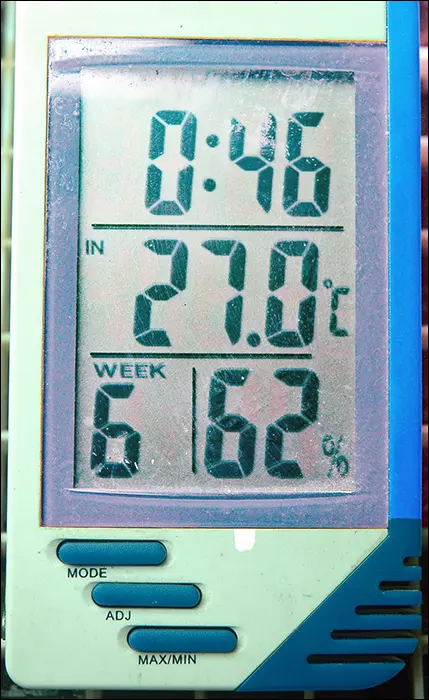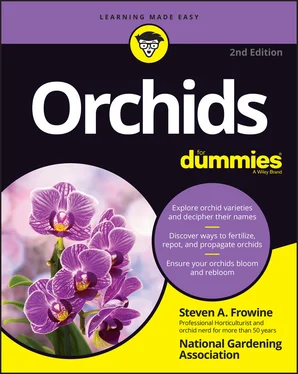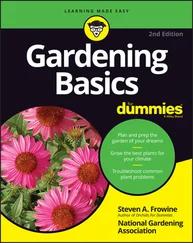PURCHASING ORCHIDS ONLINE
Here are some guidelines I use when purchasing orchids online:
Check out the vendor’s rating. If it’s below the high 90s in satisfaction ratings, check out the vendor’s responses to the complaints to make sure the ratings are reasonable. Sometimes customers can be unrealistic in their demands.
Examine the picture of the plant being offered. You should see a picture of the exact plant being offered, not a picture of a group of plants. You need to know if this picture isn’t just representational of what you might see when the plant flowers but an exact picture of the flower your plant will display. The offspring of seed-grown orchids vary dramatically so you should be aware of that.
Look closely at the plant’s foliage. Does it show discolored spots on the leaves or holes in the leaves that may indicate disease or insect damage. Is the foliage floppy and weak, which may show that it’s poorly grown?
Make sure the vendor accepts returns. Ask the vendor whether they accept a returned plant if the one you receive is in poor condition or if it isn’t the plant you ordered.
Check out the cost and speed of the shipping method. In general, you don’t want your plants to transit for more than a few days.
Try to have your plant shipped to you on a Monday. That way you don’t run the risk of the plant being held at the shippers over a weekend if the shipment somehow gets delayed.
Order when the weather is mild with daytime temperatures above freezing. If that’s not possible, make sure the shipper includes a heat pack with your shipment and guarantees live delivery. Also, avoid extremely hot times.
Home centers and discount stores
Because orchids have had such a meteoric rise in popularity, home centers and discount stores now frequently stock a limited selection of them. The good news: They usually carry the orchids that are easy to grow. The bad news: Getting information at these stores is difficult. But if you’re shopping for your first, inexpensive orchid, and if you don’t have easy access to a garden center or orchid grower, these are good places to start.
 When shopping for plants at home centers and discount stores, find out what day of the week their weekly shipments come in. That’s the day you want to be there to get the best quality and selection.
When shopping for plants at home centers and discount stores, find out what day of the week their weekly shipments come in. That’s the day you want to be there to get the best quality and selection.
Considering Your Environment
When you go to shop for orchids, you can very easily get carried away. The excitement of the moment can completely win over rational plant selection. Few beginning orchid growers take the time to consider their environment before they buy. Unfortunately, if you don’t think this through before you shop, you may end up bringing home a gorgeous orchid that’s completely wrong for you.
 If possible, always choose an orchid that comes close to fitting your growing area. Even though in Part 2of this book I give you pointers on how to modify your growing area to make it more suitable for orchid growth, you can only modify your environment so much. For instance, an orchid that is commonly found growing in full sun in Hawaii probably won’t take well to a windowsill during the winter in low-light areas like New England. And an orchid from the cloud forest that is drenched with almost constant rainfall and extremely high humidity probably won’t be happy and bloom in the hot dry air of Arizona.
If possible, always choose an orchid that comes close to fitting your growing area. Even though in Part 2of this book I give you pointers on how to modify your growing area to make it more suitable for orchid growth, you can only modify your environment so much. For instance, an orchid that is commonly found growing in full sun in Hawaii probably won’t take well to a windowsill during the winter in low-light areas like New England. And an orchid from the cloud forest that is drenched with almost constant rainfall and extremely high humidity probably won’t be happy and bloom in the hot dry air of Arizona.
In the following sections, I help you assess your environment so you can be confident that you’ll pick out a stunning orchid that is right for you and that will thrive where you live.
Taking temperature readings
Before you bring home an orchid, you need to consider the average daytime and nighttime temperatures in summer and winter where you live.
 To determine high and low temperatures indoors get a maximum/minimum thermometer that records this information and place it in your growing area. A broad selection of temperature and weather recording instruments are available from home stores, garden centers, or online. I find that a maximum-minimum thermometer (see Figure 2-1) is especially useful to determine your minimum and maximum temperatures for day and night. They’re available in digital or analog.
To determine high and low temperatures indoors get a maximum/minimum thermometer that records this information and place it in your growing area. A broad selection of temperature and weather recording instruments are available from home stores, garden centers, or online. I find that a maximum-minimum thermometer (see Figure 2-1) is especially useful to determine your minimum and maximum temperatures for day and night. They’re available in digital or analog.

© John Wiley & Sons, Inc.
FIGURE 2-1:Maximum-minimum thermometer.
For an idea of what your minimum temperatures are outdoors where you live, check out the USDA hardiness map online at https://planthardiness.ars.usda.gov/pages/view-maps . If you’re a weather geek like I am, you can use a recording weather station that reads and records the maximum and minimum temperature, humidity, wind speed, rainfall, and barometric pressure every hour and stores this information so it can be charted. Mine has remote sensors and a wireless connection to my computer.
When you’ve determined the average summer and winter temperatures in your area, turn to Table 2-1, which lists some of the most common types of orchids by temperature requirements. Notice that some orchids are adaptable enough to fit into more than one temperature range. This information is merely a guideline; if you’re off by a few degrees, especially the high degrees during the day during the summer, don’t worry about it. Orchids are adaptable.
TABLE 2-1Orchid Temperature Preferences
| Temperature (Nighttime Minimum) |
Genus |
| Cool (45°F–55°F/7.2°C–12.8°C) |
Cymbidium Dendrobium Odontoglossum |
| Cool (45°F–55°F/7.2°C–12.8°C) to Intermediate (55°F–60°F/12.8°C–15.6°C) |
Cymbidium Dendrobium Encyclia Masdevallia Miltoniopsis Zygopetalum |
| Intermediate (55°F–60°F/12.8°C–15.6°C) |
Aerangis Cattleya and hybrids Cymbidium Dendrobium Encyclia Epidendrum Laelia Maxillaria Miltonia O ncidium Paphiopedilum Phragmipedium Vanda Zygopetalum |
| Intermediate (55°F–60°F/12.8°C–15.6°C) to Warm (65°F/18.3°C or higher) |
Aerangis Amesiella Angraecum Brassavola Cattleya Dendrobium Encyclia Epidendrum Neofinetia Neostylis Oncidium Rhynchostylis Vanda Vascostylis |
| Warm (65°F/18.3°C or higher) |
Angraecum Phalaenopsis Vanda |
 When orchid publications refer to temperature preferences, they almost always mean the evening temperature. The daytime temperature is usually about 15°F (9.5°C) higher than the evening temperature.
When orchid publications refer to temperature preferences, they almost always mean the evening temperature. The daytime temperature is usually about 15°F (9.5°C) higher than the evening temperature.
Measuring your light intensity
Just as important as temperature is the amount of light your orchid will get. Orchids that thrive in high light need several hours of direct sunlight (preferably in the morning to early afternoon), or bright artificial light whereas those that thrive in lower light will perform with less direct and more diffused light in a windowsill or under less intense lights.
Читать дальше

 When shopping for plants at home centers and discount stores, find out what day of the week their weekly shipments come in. That’s the day you want to be there to get the best quality and selection.
When shopping for plants at home centers and discount stores, find out what day of the week their weekly shipments come in. That’s the day you want to be there to get the best quality and selection.
 When orchid publications refer to temperature preferences, they almost always mean the evening temperature. The daytime temperature is usually about 15°F (9.5°C) higher than the evening temperature.
When orchid publications refer to temperature preferences, they almost always mean the evening temperature. The daytime temperature is usually about 15°F (9.5°C) higher than the evening temperature.










